
The Baltimore Metropolitan Council (BMC) hosted the Unmanned Aerial Systems (UAS) Information Exchange Forum on Tuesday, December 4, 2018. This event was the culmination of 18 months of planning and generous donations from MSGIC and KCI Technologies.
Date And Time
Tuesday, December 4, 2018
9:30 AM – 4:30 PM EDT
Location
Wilde Lake Interfaith Center
10431 Twin Rivers Rd,
Columbia, MD 21044
Program and Links to Presentations
Introduction and Purpose of Forum
- Eileen Singleton, Principal Transportation Engineer, Baltimore Metropolitan Council
Welcome
- Michael Kelly, Executive Director, Baltimore Metropolitan Council
Getting Started and Regulatory Framework
- Unmanned and Unbound: The Future of Commercial UAS
- Justin Towles, Founding Partner, Ascension Global
- Getting a UAS Pilots License:Why You Need It and What It Takes to Get It
- Professor Scott Jeffrey, Center for Mapping and Analysis Program Director, Community College of Baltimore, Catonsville
- Dr. Doug Williams, Aviation Technology Program Director, Community College of Baltimore, Catonsville
Federal, State, and Local UAS Overview
- Update from Federal Highway Administration
- Connie Yew, Team Leader for Construction Management, Office of Infrastructure, Federal Highway Administration
- Overview of Maryland Association of Counties Activities to Support Local UAS Use (no slides)
- Robin Eilenberg, Research Director, Maryland Association of Counties
- Summary of Maryland Department of Transportation UAS Activities
- Laurie Goudy, IT Director, MDOT State Highway Administration
- Ross Cutts, Engineering Geology Field Manager, MDOT State Highway Administration
Sponsor Lightning Round
Local and State Use Cases of UAS Part 1: Public Sector Perspective
- Queen Anne’s County Drone Program: A Local Government Approach to Drones
- Sam Stanton, GIS Coordinator, Queen Anne’s County GIS
- Tyler Pease, GIS Specialist II, Queen Anne’s County GIS
- Maryland Transportation Authority Crash Response and Reconstruction
- Cpl. Mike Lamont, Commander – Collision Reconstruction, MDTA Police
- Procurement of UAS for Local Use
- Kim Cluney, Program Manager, Anne Arundel County Department of Public Works
- UAS on the Leading Edge of Technology
- Matt Scassero, Director, UAS Test Site
Local and State Use Cases of UAS Part 2: Private Sector Perspective
- Why UAS Will Help Your Organization
- David Headrick, Project Manager, KCI Technologies, Inc.
- Dustin Henry, Assistant Director, KCI Technologies, Inc.
- UAS Photogrammetry: Stormwater Management Existing Conditions Survey
- Eric Cooper, Associate – Chief of Surveys, Wallace Montgomery & Associates
- Pushing Engineering & Construction Boundaries with UAS
- Bryan Haynie, Vice President/Chief of Surveys, Century Engineering, Inc.
Panel Discussion: Key Points from the Day
- Facilitator: Ross Cutts, Engineering Geology Field Manager, MDOT SHA
- Procurement: Andrew Hime, Purchasing Agent, Anne Arundel County
- GIS: Patrick Callahan, GIS Manager, Office of Information Technology, Prince George’s County
- DPW /Transportation: Jeff Hobbs, Chief of Surveys, Howard County Department of Public Works
- Private sector: Al Wainger, Vice President, Michael Baker, Inc.
Closing Remarks
- Mara Kaminowitz, GIS Coordinator, Baltimore Metropolitan Council
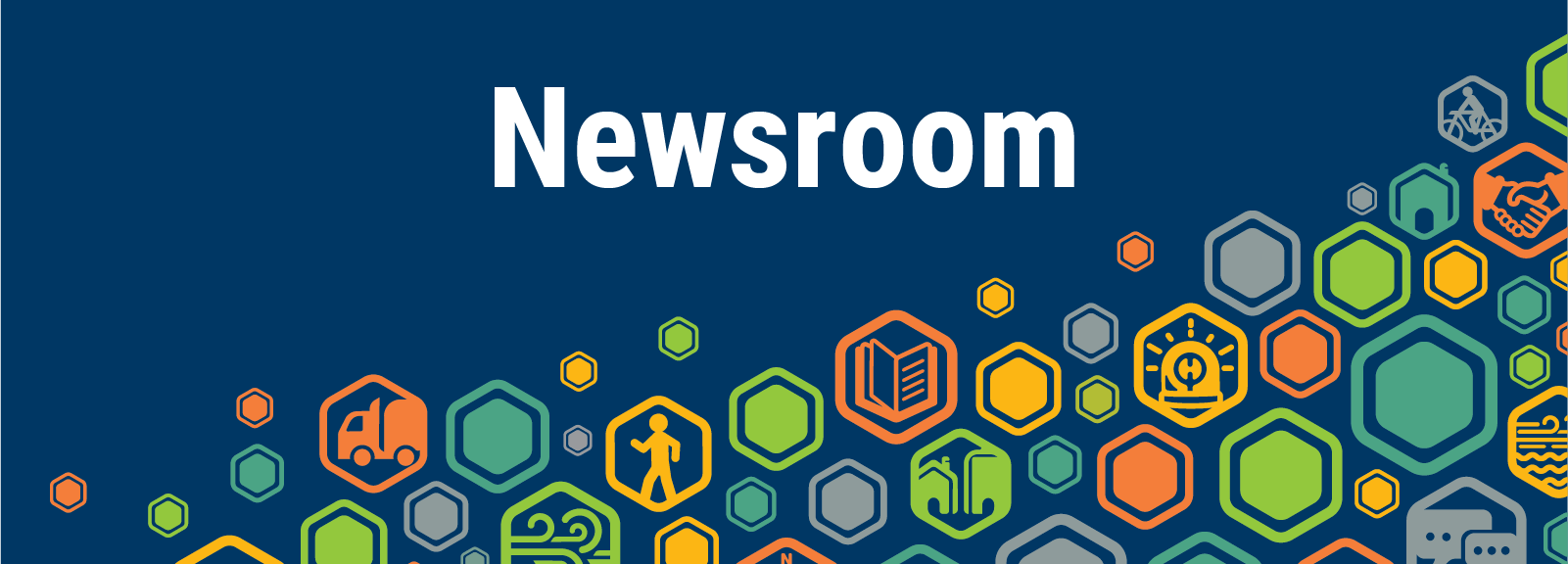
BMC’s Bala Akundi, Principal Transportation Engineer and contributor to the LOOK ALIVE Pedestrian Safety Campaign, participated in a panel, alongside representatives from the Baltimore County Police Department, Metropolitan Washington Council of Governments and the Maryland Department of Transportation Motor Vehicle Administration’s (MDOT MVA) Highway Safety Office at the Maryland Quality Initiative (MdQI) Conference on January 23, 2020.
The “Pedestrian Safety- Education and Enforcement Side” panel discussion focused on education and enforcement activities that are currently underway to help address highway safety challenges. In 2018, pedestrians accounted for 25% of the State’s highway deaths. Reducing pedestrian fatalities and serious injuries is a key emphasis area in Maryland’s Strategic Highway Safety Plan.
The MdQI Conference, which took place at the Baltimore Convention Center, drew hundreds of speakers, exhibitors and attendees to network and discuss the challenges and opportunities facing transportation professionals. MdQI aims to provide the Maryland transportation industry with a forum that supports improvements to ensure safe, efficient and environmentally sensitive and sustainable systems.
LOOK ALIVE, is a campaign in the greater Baltimore region to raise awareness and educate drivers, pedestrians and bicyclists on how to be safe on our roads. The campaign is a collaboration between BMC, the MDOT MVA Highway Safety Office and State Highway Administration (MDOT SHA), Maryland Institute for Emergency Medical Services Systems and regional transportation and law enforcement officials from Baltimore City, and Baltimore, Anne Arundel, Howard, Harford, Carroll, and Queen Anne’s counties.

The Maryland Association of Counties (MACO) held its three-day Winter Conference December 4-6, 2019 at the Hyatt Regency Chesapeake Bay Hotel in Dorchester County.
The conference brought 600 attendees, 96 speakers, over 60 exhibitors and 38 sessions. BMC was proud to participate in the “No More Deaths: Vision Zero and Maryland’s Mission for Roadway Safety” session.
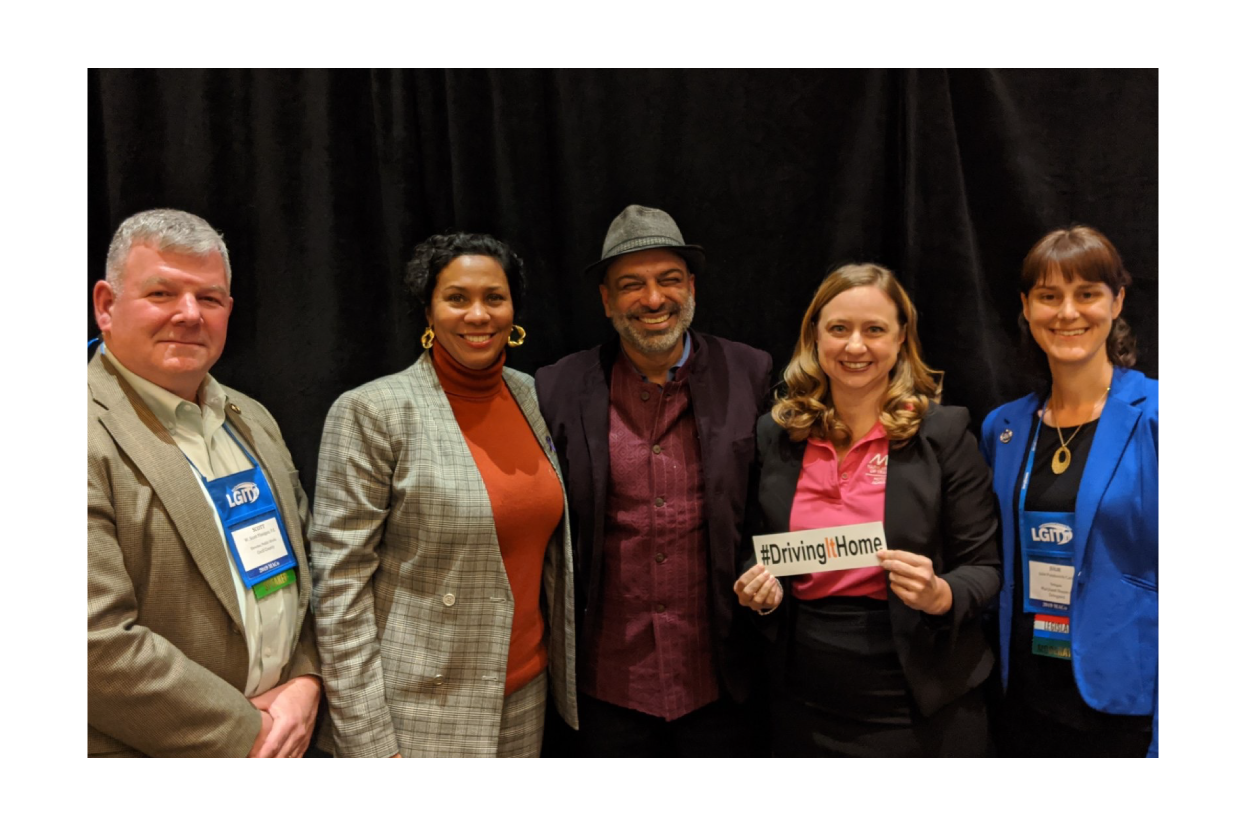 Bala Akundi, Principal Transportation Engineer with the Baltimore Metropolitan Council (BMC), was honored to attend and speak about safety on our roadways and how our transportation system is essential to connecting all Marylanders to recreational and economic opportunities. Other panelists included Monique Anderson-Walker, Prince George’s County Council Member, Christine Nizer, Administrator for the Maryland Department of Transportation - Motor Vehicle Administration (MDOT-MVA) and Scott Flanigan, Director of Public Works for Cecil County. Moderator Delegate Julie Palakovich-Carr introducing the panelists and providing an overview of Vision Zero.
Bala Akundi, Principal Transportation Engineer with the Baltimore Metropolitan Council (BMC), was honored to attend and speak about safety on our roadways and how our transportation system is essential to connecting all Marylanders to recreational and economic opportunities. Other panelists included Monique Anderson-Walker, Prince George’s County Council Member, Christine Nizer, Administrator for the Maryland Department of Transportation - Motor Vehicle Administration (MDOT-MVA) and Scott Flanigan, Director of Public Works for Cecil County. Moderator Delegate Julie Palakovich-Carr introducing the panelists and providing an overview of Vision Zero.
Each speaker shared details on the statewide effort to improve roadway safety with a goal of reaching zero vehicle-related deaths or serious injuries on roadways by the year 2030. Presentations explored how to make traffic safety an essential piece of annual planning by developing local Strategic Highway Safety Plans and tools available to complete the process.
During Akundi’s portion of the presentation, he explained the regional perspective, MPO advantages, draft plans and processes to help reach the Vision Zero goal. Since late 2018, BMC has assisted member jurisdictions in developing local Strategic Highway Safety Plans (SHSPs) in support of Maryland’s goal of Vision Zero. The Maryland Highway Safety Office (MHSO) provided grant funding to support a full-time staff position at BMC to help the local jurisdictions develop and implement the local plans over the next several years. As of December 2019, two jurisdictions have developed draft plans that are waiting approval from senior management while others have begun putting together teams to begin the process.
The MACO winter conference is an annual event and is scheduled to be held next year December 9-11, 2020.
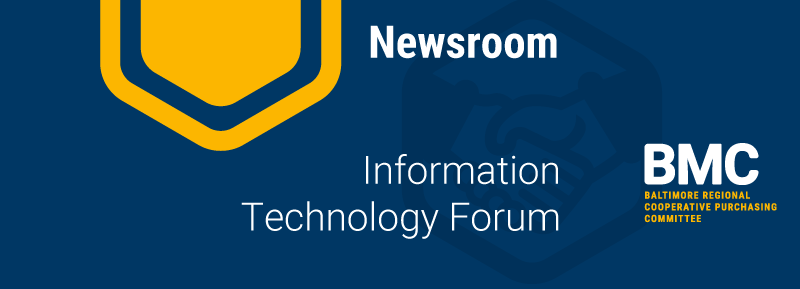
The Baltimore Regional Cooperative Purchasing Committee (BRCPC) hosted an IT Forum at the Baltimore Metropolitan Council’s offices on December 2, 2019 welcoming approximately 40 attendees.
Each year, BRCPC members identify areas of training that will enhance the ability of staff to perform their duties.
Last year, the forum focused on sustainability, while this year, IT was chosen. Technology and cyber matters are popular subjects. The one-day event started with a look into trending technology, including artificial intelligence, block chain and apps. Participants then dove into the State of Maryland’s new eMaryland Marketplace Advantage product, cyber insurance, and network penetration testing models. They also discussed modernizing data centers, the nature of cyber threats, and strategies for building team support for innovation.
This event was attended by all levels of government in a variety of divisions including staff from procurement, IT, executive and diversity offices.
The forum provided both the training needed to develop solid procurements that reduce risk to the entity and improve the product or service procured, as well as important industry insight into the constantly changing technology and cyber security markets. The event also convened diverse departments to understand each other’s needs and challenges.
The IT Forum provided essential training and also allowed professionals the opportunity to network with their peers. This facilitates a collaborative environment that is necessary to further cooperative purchasing goals.
This training program was coordinated by Debbie Groat, Cooperative Purchasing Director, as a member benefit. All participants were BRCPC members, who attended the forum free of charge. BMC is proud to provide this value-added benefit, designed to enhance the core competencies of our region’s professionals.
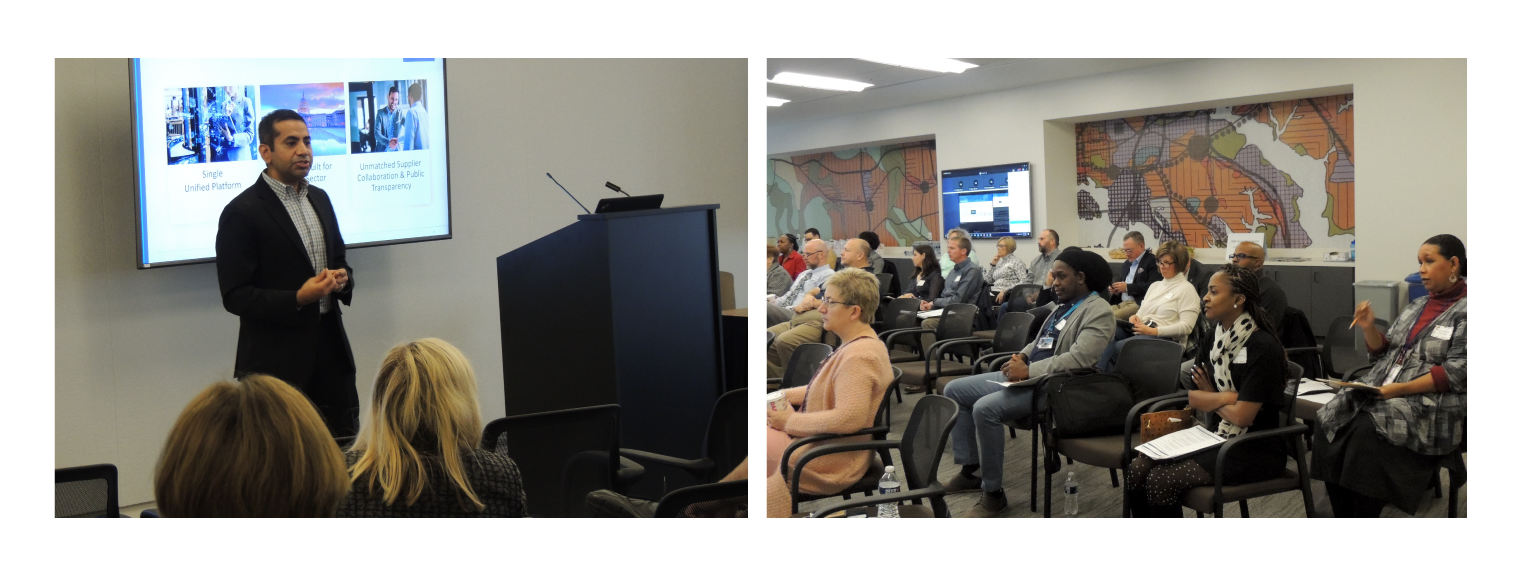 |

On Friday, November 15th the Association of School Business Officials (ASBO) held their 68th Annual Fall MD and DC Conference at the Maritime Conference Center in Linthicum.
The one-day professional development conference provided presentations and discussions around leadership development, facilities, as well as trends in human resources, purchasing, and school business solutions.
BMC’s Cooperative Purchasing Director, Debbie Groat, was invited to join a panel discussion, entitled: “Cooperative Purchasing for School Roofing Construction.” The session was facilitated by Carla Viar Pullen, Facilities Planner for Queen Anne’s County Public Schools. The panel included representatives from the Garland Company and Jeffrey LaPorta, Executive Director of ASBO MD & DC. The group delved into alternative methods for bidding roofs, learned proven processes for reducing costs, and explored options to structure bids to optimize savings.
Debbie Groat provided additional details on the continued value of cooperative purchasing as a solution to rising costs and options for when competitive bidding falls short..
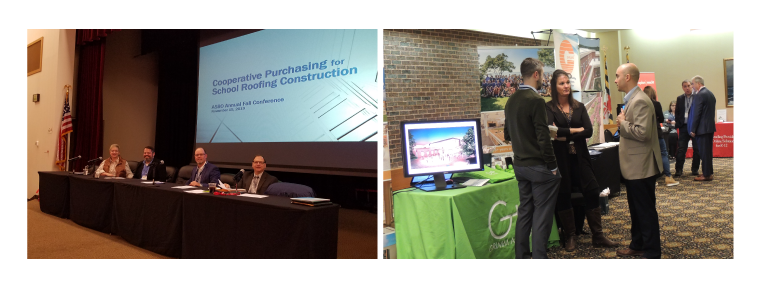 |

With the Thanksgiving holiday quickly approaching, many Marylanders will hit the roads to be with their families. Holiday travel is stressful enough without the annoyance of bumper-to-bumper traffic and hours of delays. Instead of going with the flow, here are some tips on how to make your travel a little bit easier this week.
The Maryland Transportation Authority (MdTA) estimates that more than 3.4 million travelers will drive on its highways, bridges and tunnels this Thanksgiving. This estimate forecasts a slight increase in travel from last year’s Thanksgiving holiday traffic.
In previous years, the Wednesday before Thanksgiving was considered the busiest travel day of the year. Although Wednesday, November 27, is expected to be the heaviest travel day, data shows that families trying to beat the rush have increased traffic on the Tuesday before Thanksgiving as well.
Using crowdsourced vehicle probe data, we have determined that peak travel occurs in the 4 o’clock hour on both the Tuesday and Wednesday of Thanksgiving week, making this one of the worst times to travel. Speed maps from Tuesday and Wednesday of Thanksgiving week 2018 show where traffic problems occurred.
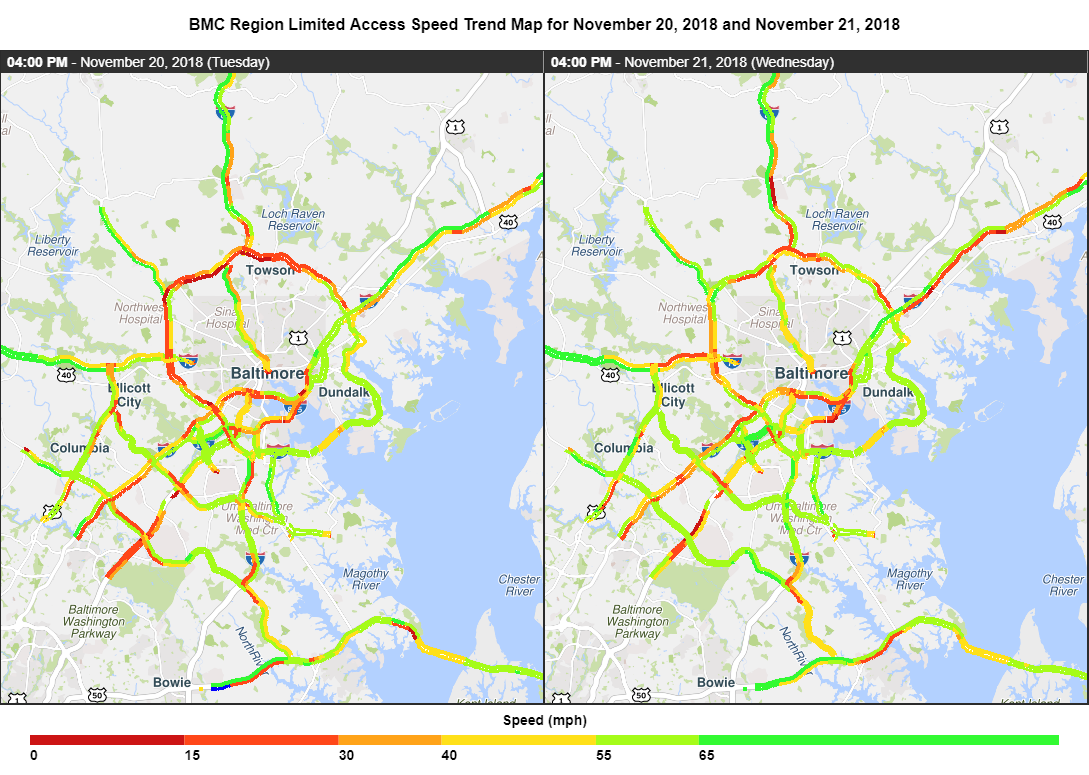 |
By looking at the data from last year, those who had been thinking of leaving a day early on Tuesday to get a jump on traffic may have been surprised, as traffic was very heavy throughout the region. However, as you can see in the map below, I-95 northbound appeared significantly slower on Wednesday north of the beltway approaching Harford County at the peak travel hour. The Baltimore Beltway was showing heavier traffic on Tuesday last year primarily due to crashes.
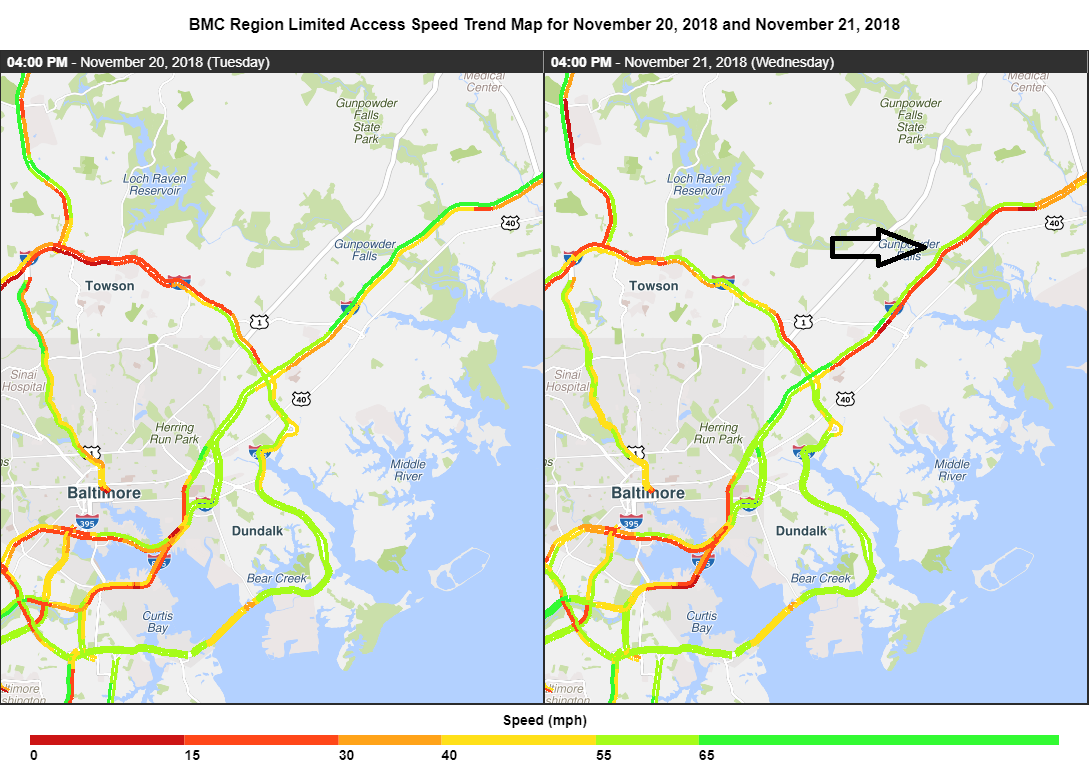 |
The following animated maps show speeds on the major highways of the Baltimore Region on the Tuesday and Wednesday before Thanksgiving in 2018. Just press play to see a 24-hour time-lapse animation of both days side by side. Pan around and zoom in or out to take see what conditions on your family’s route to Thanksgiving dinner may look like this year.
Travel advisories:
As for the best times to travel, our partners at the Maryland Transportation Authority (MdTA) offer these travel tips for the Thanksgiving Day holiday:
Bay Bridge:
The deck surface of the Bay Bridge right lane has reached the end of its service life and is severely deteriorated. To expedite the rehabilitation project, crews are working day and night, seven days a week, and will continue during Thanksgiving week. This will save significant time because crews not only gain the work week, but didn’t have to stop work in advance of the holiday to prepare the right lane for traffic. That process would have involved removing jersey barriers and restriping lanes.
Motorists should expect major delays in both directions and plan to leave an extra 20 to 30 minutes early if crossing the bridge. Recommended times to travel the Bay Bridge during the Thanksgiving holiday are:
Eastbound:
- Tuesday through Friday, November 26-29, before 9 a.m. and after 9 p.m.
- Monday, December 2, before noon and after 8 p.m.
Westbound:
- Tuesday and Wednesday, November 26-27, before 5 a.m. and after 6 p.m.
- Thursday through Sunday, November 28-December 1, before 9 a.m. and after 9 p.m.
- Monday, December 2, before 5 a.m. and after 2 p.m.
I-95 Corridor
MdTA is reminding motorists using I-95 to travel these off-peak hours:
- Tuesday and Wednesday, November 26-27, before 6 a.m. and after 11 p.m.
- Thursday and Friday, November 28-29, before 7 a.m. and after 9 p.m.
- Saturday and Sunday, November 29-30, before 9 a.m. and after 9 p.m.
The Baltimore Metropolitan Council (BMC)’s congestion management process analyzes where and when traffic in the Baltimore region tends to pile up and for how long it will stay congested by looking at data from various crowdsourced probe data sources. According to the Maryland Transportation Authority (MdTA) who manage the region’s toll facilities, travelers should consider departing during off-peak hours to avoid significant delays along the I-95 corridor.
*All graphics and animations are generated in cooperation with the I-95 Corridor Coalition, Probe Data Analytics Project and the University of Maryland Center for Advanced Transportation Technologies (CATT) Lab. Vehicle probe data provided by INRIX. Advisories provided by the Maryland Transportation Authority (MdTA)
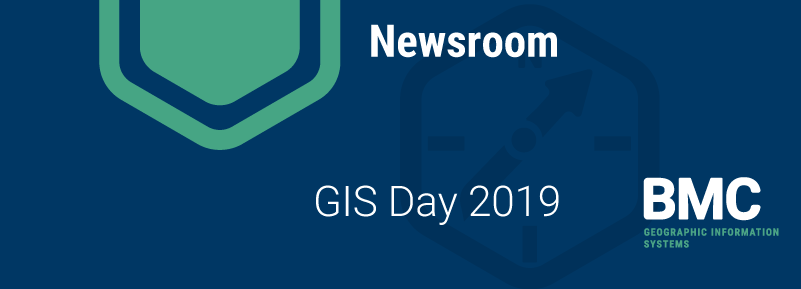
Baltimore City hosted its Annual GIS Day on Friday, November 15th at the War Memorial Building downtown. The event showcased the geospatial and mapping work being done in Baltimore by city agencies and other local organizations.
The gathering included a wide display of data, technology and GIS work open to the public for review and discussion. It also created a platform for exhibitors and attendees to collaborate and share GIS practices with each other.
Exhibitors included many city agencies, MD iMap (MD Department of IT), BMC, Johns Hopkins, and the Baltimore Neighborhood Indicators Alliance. Among the over 300 attendees were city employees from many agencies, members of the community, and students.
The Baltimore Metropolitan Council was excited to be included in the event presenting maps and apps created by our GIS team that illustrate information about the city and its relationship to the broader region. We also spoke about our work in general and how it benefits the city and the region.
At our table, we gave away maps that showed travel patterns to and from the city. This allowed guests to understand where people who work in Baltimore commute from, and where people living in the city go to work.
We also presented our regional bicycle facilities map, which attracted many throughout the day. Attendees were interested in seeing bicycle trails in their neighborhood and comparing facilities across different counties.
Another popular display was our interactive traffic dashboard. I Participants entered their address into the application to look at traffic conditions in their area. This led to conversations about what else BMC was doing to address the issue, including traffic safety and congestion management.
The event welcomed Digital Harbor GIS Track students. The students learned more about professional GIS work. Each student visited the map and data-covered tables, where exhibitors were eager to share their wealth of knowledge and answer questions to encourage their growth and development within the field. While many learned new information about map and data resources from visiting the BMC table, we are proud to note that the students from Digital Harbor plan to use BMC's open data for their school projects.
This is the first year BMC’s GIS team participated in this event. We are fortunate to communicate through our research, data and strategies just how interconnected our region is. We look forward to next year’s event and all that we can learn, give and discuss with next year’s attendees.
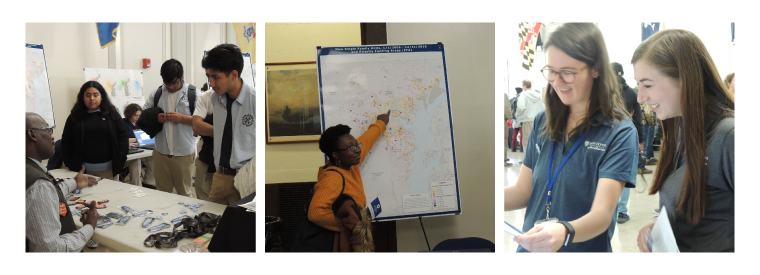 |

The Baltimore Metropolitan Council (BMC) and its state and local partners are happy to announce the launch of its new, regional pedestrian and bicycle safety campaign for the Baltimore Region – LOOK ALIVE, featuring Signal Woman. The campaign launched on Monday June 3, 2019 at Olympian Park in Towson. Speakers included Baltimore Metropolitan Council Executive Director Mike Kelly, Baltimore County Executive John Olszewski, Jr., Maryland Department of Transportation (MDOT) Motor Vehicle Administrator Chrissy Nizer, MDOT State Highway Administration Office of Traffic and Safety Director Cedric Ward, and Baltimore County Police Department Captain Joseph Donahue.
LOOK ALIVE, is a new campaign in the greater Baltimore region to raise awareness and educate drivers, pedestrians and bicyclists on how to be safe on our roads. The campaign is a collaboration between BMC, the Maryland Department of Transportation Motor Vehicle Administration’s (MDOT MVA) Highway Safety Office and State Highway Administration (MDOT SHA), Maryland Institute for Emergency Medical Services Systems and regional transportation and law enforcement officials from Baltimore City, and Baltimore, Anne Arundel, Howard, Harford, Carroll, and Queen Anne’s counties.
Click here to download and share LOOK ALIVE resources with your community.
While traffic fatalities in Maryland declined last year overall, the number of pedestrians killed on state roads in 2018 was 133, an increase of 12 percent from 2017.
According to the Governor’s Highway Safety Association, the biggest factors in pedestrian and bicyclist deaths are vehicle speed, distraction, time of day and alcohol use. The LOOK ALIVE campaign, which runs through the fall, relays a message of safety and awareness.
Efforts such as traffic calming, making crosswalks more prominent and visible, shifting lanes, lowering speed limits where appropriate, and providing more protective space for pedestrians and bicyclists are regional and statewide priorities for MDOT SHA.
LOOK ALIVE integrates several components, including television, outdoor, digital engagement, community outreach, and media relations. Education is coupled with high visibility enforcement waves, in which police put an added emphasis on enforcing traffic safety laws to protect people walking and biking in the greater Baltimore region.
For more information, please visit www.lookalivemd.org.

The Baltimore Metropolitan Council (BMC) seeks qualified firms or organizations to provide professional services to: (1) develop a strategy for a Congestion Management Process (CMP); and (2) develop a template for corridor studies for the Baltimore region.
Proposals must be received by BMC no later than Friday, June 28, 2019, at 2 p.m.
Written questions about this procurement should be sent to Regina Aris at raris@baltometro.org or (410) 732-8248 (fax) no later than Monday, June 17. Answers to questions will be posted on the BMC website no later than Wednesday, June 19.

Michael E. Busch, Speaker of the Maryland House of Delegates, died today at the age of 72. "Speaker Busch's tireless advocacy for the Baltimore region made it a better place for all of us. His support and steadfast leadership will be missed throughout the entire state. Our condolences go out to his family and loved ones during this challenging time," said Executive Director Michael B. Kelly.
